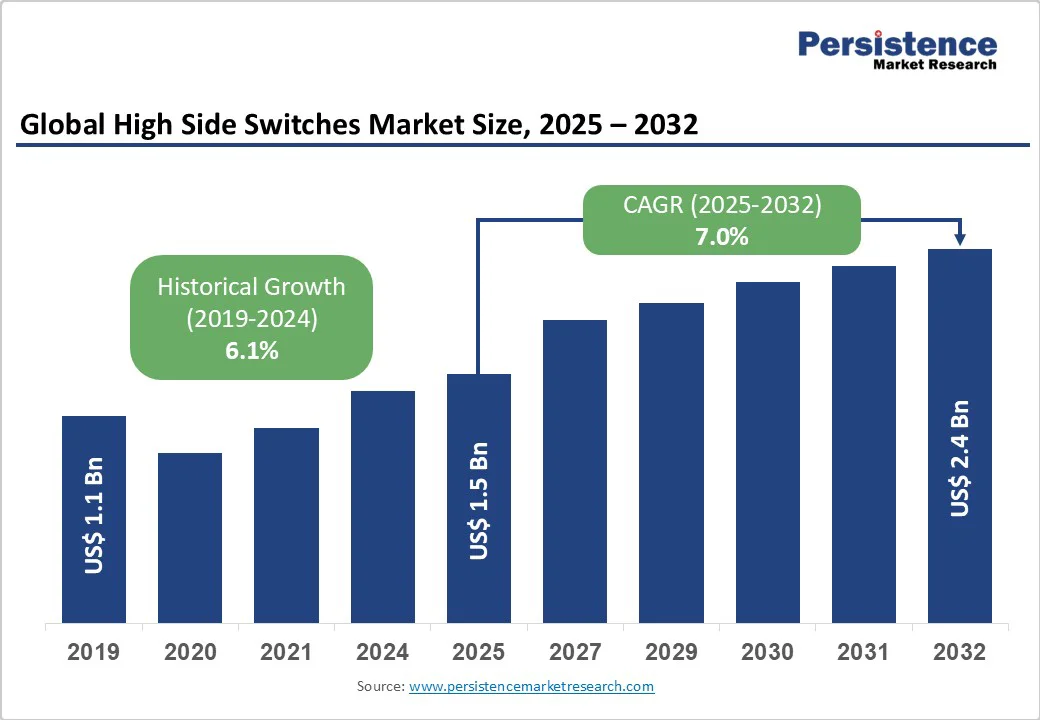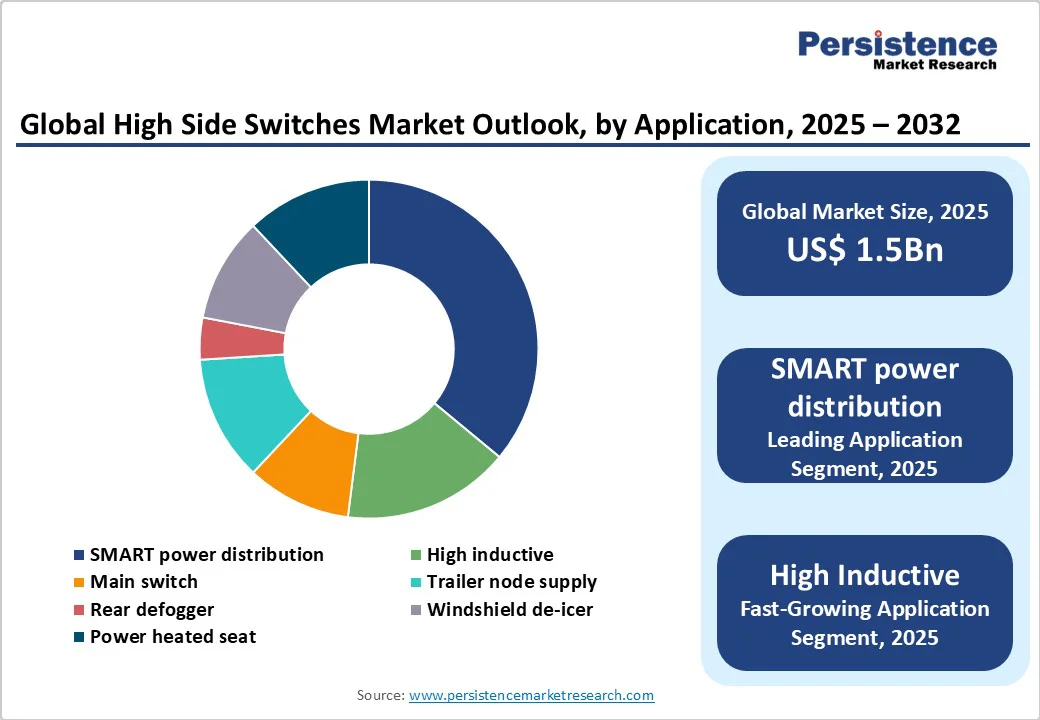ID: PMRREP26686| 182 Pages | 29 Sep 2025 | Format: PDF, Excel, PPT* | Semiconductor Electronics

The global high side switches market size is likely to value at US$1.5 Bn in 2025 and expected to reach US$2.4 Bn by 2032, registering a robust CAGR of 7.0% during the forecast period from 2025 to 2032, fueled by the increasing demand for efficient power management solutions, advancements in semiconductor technologies, and a global push toward enhancing automotive electronics and smart systems.
| Key Insights | Details |
|---|---|
| High Side Switches Market Size (2025E) | US$1.5 Bn |
| Market Value Forecast (2032F) | US$2.4 Bn |
| Projected Growth (CAGR 2025 to 2032) | 7.0% |
| Historical Market Growth (CAGR 2019 to 2024) | 6.1% |

The global surge in demand for efficient power management is a primary driver of the high side switches market. According to the International Energy Agency (IEA), global electric vehicle (EV) sales are projected to reach 21.3 million units in 2025, representing 24% of total car sales worldwide, with the technology enabling advanced battery management systems essential for range extension and fast charging initiatives.
This prevalence is aggravated by the rapidly growing adoption of electrified vehicles, with EV ownership rising significantly, and increasing lifestyle-related mobility shifts, with automotive electronics becoming a leading global transportation burden.
In response, governments and automakers are investing heavily in power electronics infrastructure, with the United States leading in adoption of high side switches for EV power distribution to address battery protection gaps. In Europe, where EV rollouts are steadily increasing, initiatives such as the EU's Green Deal emphasize energy-efficient switching solutions.
The automotive electronics sector, which represents a substantial portion of global vehicle expenditure, is increasingly relying on high side switches to manage high-voltage constraints in electrified powertrains. In the Asia Pacific, young demographics and rapid urbanization drive demand for reliable solutions such as single and dual-channel switches. Growing R&D investments in EV power management are promoting advanced switches with integrated diagnostics, improving safety by reducing overheating risks, and enabling precise current control.
High side switches are also being integrated into applications such as windshield de-icers and power heated seats, extending their utility beyond core EV functions. As supply chain pressures ease, manufacturers are scaling production of silicon carbide-based switches, which offer lower on-resistance and higher efficiency. Regulatory pressures, including stricter emissions standards, further encourage adoption. Collectively, these factors position high side switches as indispensable components, driving sustained market growth.
The high side switches market faces significant restraints due to high production costs and stringent regulatory requirements, which limit broader adoption, particularly in price-sensitive segments. Manufacturing advanced switches requires premium materials such as silicon carbide (SiC) and gallium nitride (GaN) semiconductors, which are expensive and necessitate sophisticated fabrication processes to ensure reliability under extreme automotive conditions, including high temperatures and voltages.
The costs are further increased by rigorous quality assurance and safety testing to meet automotive-grade standards, including accelerated life testing and fault simulations. Integration of diagnostic features for overcurrent and overtemperature protection adds complexity and raises unit prices compared to simpler low-side alternatives.
In emerging markets, budget constraints often favor lower-cost substitutes, slowing adoption. Evolving regulations, such as RoHS and ISO 26262, require continuous redesigns and certifications, diverting resources from innovation.
Supply chain vulnerabilities and semiconductor shortages contribute to price volatility, while a shortage of skilled power electronics engineers increases development costs. These factors create high entry barriers, challenging manufacturers to balance cost and performance, potentially limiting growth in non-premium applications.
The high side switches market presents significant opportunities through innovations in sustainable designs and expansion into multi-application domains, enabling manufacturers to target sectors such as renewable energy integration and advanced driver-assistance systems (ADAS). Growing global sustainability mandates are driving demand for eco-friendly switch designs that minimize energy losses and incorporate recyclable materials, aligning with initiatives such as the UN Sustainable Development Goals and corporate net-zero commitments.
Next-generation switches with ultra-low RDS(on) reduce power dissipation in EV traction inverters, extending battery life and appealing to environmentally conscious OEMs. High side switches also enable efficient power conversion in solar inverters and wind turbine controls, while their robustness allows repurposing for industrial automation, smart home devices, and medical equipment.
Advances in integrated circuits, including MOSFETs with built-in protection against electrostatic discharge, simplify system design and reduce costs. Digital marketplaces and e-commerce platforms expand access, particularly for SMEs in the Asia Pacific, while AI-driven predictive analytics in switches support real-time fault detection in safety-critical applications.
Strategic collaborations and R&D in wide-bandgap technologies further unlock revenue opportunities, allowing market players to diversify beyond automotive applications and achieve sustained, cross-sector growth.
The high side switches market is segmented into single, dual, and quad. Single dominant, holding approximately 38% share in 2025, due to their proven efficacy in targeted load switching, high precision, and integration into standard automotive protocols. Single-channel switches are widely used in main switches, offering robust overcurrent protection that minimizes failures.
Dual is the fastest-growing segment, driven by increasing demand for multi-load management in compact systems. Dual channel switches provide versatile control as integrated options, with advancements in miniaturization and thermal efficiency making them suitable for long-term use in dense EV architectures.
By application, the market is segmented into SMART power distribution, main switch, trailer node supply, rear defogger, windshield de-icer, power heated seat, high inductive, and others. SMART power distribution, holding approximately 36% share in 2025, due to their proven efficacy in intelligent energy routing, diagnostic capabilities, and integration into vehicle protocols. SMART power distribution is widely used in EV systems, offering fault-tolerant switching that enhances reliability.
High inductors are the fastest-growing, driven by increasing demand for inductive load handling in motors and solenoids. These applications provide surge protection as specialized systems, with advancements in avalanche-rated designs and fast demagnetization making them suitable for long-term use in advanced powertrains.

North America dominates the global high side switches market, expected to account for 32% share in 2025, driven by a robust automotive ecosystem, high infrastructure investments, and a cultural emphasis on digital connectivity and innovation.
The United States stands out as a global leader in the adoption and development of high side switches, driven by its advanced electric vehicle (EV) manufacturing ecosystem and substantial investments in power electronics research and development.
Major automakers, including Tesla and General Motors, are increasingly integrating these switches to optimize battery management, improve energy efficiency, and enhance thermal control systems, ensuring higher performance and safety in electric and hybrid vehicles. Government initiatives, particularly the Inflation Reduction Act, incentivize domestic semiconductor production, indirectly boosting switch manufacturing capacity.
Additionally, North America benefits from a strong presence of key industry players and a growing focus on advanced driver-assistance systems (ADAS) and autonomous driving technologies. Rising consumer demand for comfort and luxury features such as power heated seats, advanced infotainment systems, and rear defoggers further accelerates the adoption of high side switches in premium EV segments.
Europe commands a significant portion of the global high side switches market, led primarily by Germany and France.
Germany’s dominance stems from its strong automotive industry and adoption of Industry 4.0 practices, with manufacturers such as Volkswagen and BMW integrating high side switches into advanced power distribution systems for next-generation electric vehicles.
France’s market growth is fueled by substantial investments in renewable energy and sustainable mobility, reinforced by regulatory frameworks such as the European Battery Regulation that promote efficient and reliable power components.
The EU’s stringent emissions standards and emphasis on circular economy principles are driving innovation in energy-efficient designs, boosting the use of high side switches in applications such as windshield de-icers, high inductive loads, and other automotive systems. This combination of industrial expertise, supportive policy, and technological innovation positions Europe as a critical player in the high side switches sector.
Asia Pacific is emerging as the fastest-growing market for high side switches, fueled by rapid vehicle production and widespread electrification in key countries such as China and India. China leads due to its status as the world’s largest electric vehicle producer, with initiatives under the "New Energy Vehicle Industry Development Plan" accelerating the integration of high side switches in trailer node supplies and main switch applications.
India’s market expansion is supported by growing automotive assembly infrastructure and government incentives such as the FAME-II scheme, which promotes EV adoption and incorporates switches for power management in two-wheelers and commercial vehicles.
The region’s cost-effective manufacturing capabilities, combined with rising middle-class demand for feature-rich vehicles, are driving significant opportunities for quad-channel switches in multi-load automotive scenarios, making Asia Pacific a central hub for both innovation and volume growth in the high side switches sector.

The global high side switches market is highly competitive, with global and regional players competing through innovation, competitive pricing, and reliability. The rise of SiC-based switches and integrated diagnostics intensifies competition, as companies strive to meet the diverse needs of automotive and industrial sectors. Strategic partnerships, mergers, and certifications for AEC-Q100 standards are key differentiators in this dynamic market.
The high side switches market is projected to reach US$1.5 Bn in 2025.
Rising demand for power management, technological advancements in designs, and government initiatives for electrification are key drivers.
The high side switches market is poised to witness a CAGR of 7.0% from 2025 to 2032.
Innovations in smart switching and multi-application designs, such as EV integration, present significant growth opportunities.
Infineon Technologies AG, Texas Instruments Incorporated, STMicroelectronics N.V., ON Semiconductor Corporation, NXP Semiconductors N.V., Analog Devices, Inc., Renesas Electronics Corporation, Microchip Technology Inc. are among the leading players, known for their innovative switch solutions.
| Report Attribute | Details |
|---|---|
| Historical Data/Actuals | 2019 - 2024 |
| Forecast Period | 2025 - 2032 |
| Market Analysis | Value: US$ Bn Volume: As Applicable |
| Geographical Coverage |
|
| Segmental Coverage |
|
| Competitive Analysis |
|
| Report Highlights |
|
By Channel Type
By Application
By Region
Delivery Timelines
For more information on this report and its delivery timelines please get in touch with our sales team.
About Author